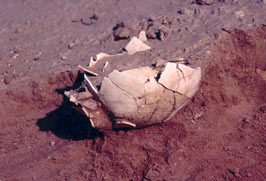
|
||||
|
|
||||
|
|
|
Ancient fires reshaped the Australian landscape
07.07.2006 -- Nearly 50,000 years ago, Australia's early humans apparently lit massive fires that reshaped the landscape of that continent, and helped drive many animal species into extinction. By studying the chemcial analysis of ancient emu eggs and wombat teeth, geologist Gifford Miller, University of Colorado has found that these animals dramatically changed their diets between 50,000 and 45,000 years ago. After having spent almost 100,000 years of having a variety of grasses as part of their diet, these animals began to eat only shrubs, trees and herbs. Those now-extinct animals couldn't adapt quickly enough to survive in areas where shrubs rapidly replaced burned-out grasses. Miller's observations were taken at three sites in central and southeastern Australia. Human colonization of Australia occurred much earlier than in the Americas. Occupation was widespread by 45,000 years ago, well before the climatic upheavals at the end of the last glacial cycle. But environmental changes following human arrival in Australia have been difficult to resolve because few continuous environmental records extend back far enough to securely compare conditions before and after human colonization. Miller provides such a record based on dietary reconstructions of the continent's two largest bird species. The results indicate that human arrival resulted in a profound environmental shift. New eggshell evidence indicates that the Australian emu and the extinct giant flightless bird Genyornis (which died out in Australia around 50,000 years ago) had eaten mostly grasses. Miller and his co-workers examined specific forms of carbon in eggshells and teeth to determine whether the ancient animals ate primarily grasses and shrubs. Teeth of the marsupial wombat, a grazer, exhibit the same reduction in food sources at the same time as shown by emu eggshells. Although no evidence of marked changes in climate occurred in Australia 50,000 years ago, people first reached Australia at about that time, and probably set fire to large swaths of grass to clear passageways and improve their hunting chances along the fire front. "People fired up Aussie extinctions"; Of Note; Science News, Vol. 168, No. 4, Pg. 61; Science Service; Washington, DC; 23 July 2005. Gifford Miller; "Detecting human impacts on the flora, fauna, and summer monsoon of Pleistocene Australia"; PAGES: Past Global Changes; http://www.pages2005.org/mediaroom/miller.html; 2005; accessed 07 July 2006. This information is provided for educational purposes under the provisions of "The Fair Use Act of 1976".
|
||
|
|
||||
